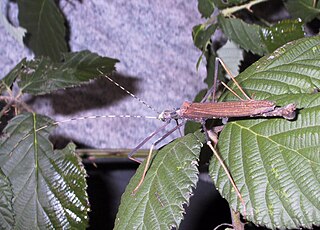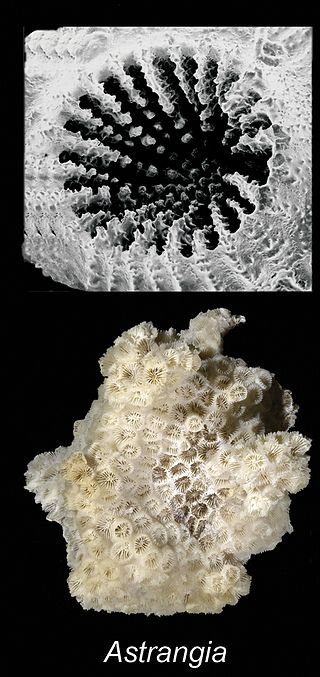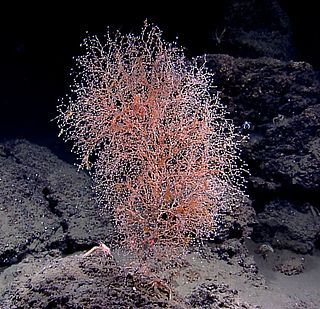
Idiospermum is a monotypic genus in the family Calycanthaceae. The sole included species is Idiospermum australiense − commonly known as idiotfruit, ribbonwood, or dinosaur tree − which is found only in two small areas of the tropical rainforests of northeastern Queensland, Australia. It is a relic of the ancient forests of Gondwana, surviving in very localised refugia for 120 million years, and displaying features that are almost identical to fossil records from that time. As such it provides an important insight into the very early evolution of flowering plants.

Octocorallia is a class of Anthozoa comprising over 3,000 species of marine organisms formed of colonial polyps with 8-fold symmetry. It includes the blue coral, soft corals, sea pens, and gorgonians within three orders: Alcyonacea, Helioporacea, and Pennatulacea. These organisms have an internal skeleton secreted by mesoglea and polyps with eight tentacles and eight mesentaries. As with all cnidarians these organisms have a complex life cycle including a motile phase when they are considered plankton and later characteristic sessile phase.

Haplochromis is a ray-finned fish genus in the family Cichlidae. It has been used as the default "wastebin taxon" for Pseudocrenilabrinae cichlids of the East African Rift, and as such became the "largest" fish "genus". Many of these cichlids are popular aquarium fishes; like similar Haplochromini they are known as "haplos", "happies" or "haps" among aquarium enthusiasts.

Pseudophasmatidae is a family of stick insect, in the suborder Verophasmatodea, commonly called the "striped walkingsticks". An important identifying characteristic is its mesothorax, which is never more than three times as long as the prothorax.

Bayerotrochus is a genus of sea snails, marine gastropod mollusks in the family Pleurotomariidae.

Holaxonia is a suborder of soft corals, a member of the phylum Cnidaria. Members of this suborder are sometimes known as gorgonians and include the sea blades, the sea fans, the sea rods and the sea whips. These soft corals are colonial, sessile organisms and are generally tree-like in structure. They do not have a hard skeleton composed of calcium carbonate but have a firm but pliable, central axial skeleton composed of a fibrous protein called gorgonin embedded in a tissue matrix, the coenenchyme. In some genera this is permeated with a calcareous substance in the form of fused spicules. Members of this suborder are characterized by having an unspiculated axis and often a soft, chambered central core. The polyps have eight-fold symmetry and in many species, especially in the families Gorgoniidae and Plexauridae, contain symbiotic photosynthetic algae called zooxanthellae. These soft corals are popular in salt water aquaria.

Balanophyllia is a genus of solitary corals in the order of stony corals.

Primnoidae is a family of soft corals.

Astrangia is a genus of stony corals in the family Rhizangiidae. Members of this genus are non-reef building corals and are found in the Atlantic and Indo-Pacific Oceans. They are solitary corals with large polyps and are found in clumps. They reproduce from stolons. The corallites are small with simple toothed septa.

Chrysogorgia is a genus of soft corals in the family Chrysogorgiidae.

Callogorgia is a genus of deep sea corals that are ideally suited to be habitats for different organisms. They reproduce both sexually and asexually, clinging to the hard substrate of the ocean during their maturation process. Callogorgia are found at depths ranging from 750-8200 feet in the Gulf of Mexico, Pacific Ocean and the Caribbean Sea. An array of organisms have relationships with Callogorgia, including brittle stars, cat sharks, and copepods. The nature of these relationships are often commensal, with Callogorgia providing a habitat for the organisms.
Callogorgia elegans is a species of soft corals in the family Primnoidae. It is found in the north-western Pacific Ocean. Like other coral species, C. elegans is bottom-dwelling and sessile, or immobile.

Aciagrion fragile is a species of damselfly in the family Coenagrionidae, commonly known as a blue slim. It is a small, slender damselfly, the male is blue and black. It has been recorded from northern Australia, New Guinea and the Lesser Sunda Islands in Indonesia, where it inhabits still waters and swamps.

Heterocyathus is a genus of coral of the family Caryophylliidae.
Pseudotetracha is a genus of tiger beetles in the family Cicindelidae, formerly included within the genus Megacephala, and endemic to Australia.

Narella is a genus of deep-sea soft corals in the family Primnoidae (Milne Edwards, 1857). They are sessile, bottom-dwelling organisms that can be found in all ocean basins, having cosmopolitan distribution. They have a branching appearance.

Coenocyathus is a genus of cnidarians belonging to the family Caryophylliidae.
Pleurogorgia is a genus of corals belonging to the family Chrysogorgiidae.

Parastenella is a genus of cnidarians belonging to the family Primnoidae.

Trochocyathus is a genus of corals in the family Caryophylliidae. Living species are found in waters near Hawai'i at depths of 64 to 1,020 meters. Fossil species are found as far back as the latest Paleocene in the Dilwyn Formation of Australia, in the late Cretaceous in the Woodbury Formation of New Jersey, and in Suffolk.


















